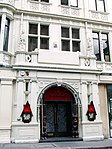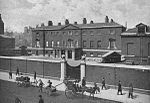Piccadilly () is a road in the City of Westminster, London, to the south of Mayfair, between Hyde Park Corner in the west and Piccadilly Circus in the east. It is part of the A4 road that connects central London to Hammersmith, Earl's Court, Heathrow Airport and the M4 motorway westward. St James's is to the south of the eastern section, while the western section is built up only on the northern side. Piccadilly is just under 1 mile (1.6 km) in length, and it is one of the widest and straightest streets in central London.
The street has been a main thoroughfare since at least medieval times, and in the Middle Ages was known as "the road to Reading" or "the way from Colnbrook". Around 1611 or 1612, a Robert Baker acquired land in the area, and prospered by making and selling piccadills. Shortly after purchasing the land, he enclosed it and erected several dwellings, including his home, Pikadilly Hall. What is now Piccadilly was named Portugal Street in 1663 after Catherine of Braganza, wife of Charles II, and grew in importance after the road from Charing Cross to Hyde Park Corner was closed to allow the creation of Green Park in 1668. Some of the most notable stately homes in London were built on the northern side of the street during this period, including Clarendon House and Burlington House in 1664. Berkeley House, constructed around the same time as Clarendon House, was destroyed by a fire in 1733 and rebuilt as Devonshire House in 1737 by William Cavendish, 3rd Duke of Devonshire. It was later used as the main headquarters for the Whig party. Burlington House has since been home to several noted societies, including the Royal Academy of Arts, the Geological Society of London, the Linnean Society, and the Royal Astronomical Society. Several members of the Rothschild family had mansions at the western end of the street. St James's Church was consecrated in 1684 and the surrounding area became St James Parish.
The Old White Horse Cellar, at No. 155, was one of the most famous coaching inns in England by the late 18th century, by which time the street had become a favoured location for booksellers. The Bath Hotel emerged around 1790, and Walsingham House was built in 1887. Both the Bath and the Walsingham were purchased and demolished, and the prestigious Ritz Hotel built on their site in 1906. Piccadilly Circus station, at the east end of the street, was opened in 1906 and rebuilt to designs by Charles Holden between 1925 and 1928. The clothing store Simpson's was established at Nos. 203–206 Piccadilly by Alec Simpson in 1936. During the 20th century, Piccadilly became known as a place to acquire heroin, and was notorious in the 1960s as the centre of London's illegal drug trade. Today, it is regarded as one of London's principal shopping streets. Its landmarks include the Ritz, Park Lane, Athenaeum and Intercontinental hotels, Fortnum & Mason, the Royal Academy, the RAF Club, Hatchards, the Embassy of Japan and the High Commission of Malta.
Piccadilly has inspired several works of fiction, including Oscar Wilde's The Importance of Being Earnest and the work of P. G. Wodehouse. It is one of a group of squares on the London Monopoly board.









